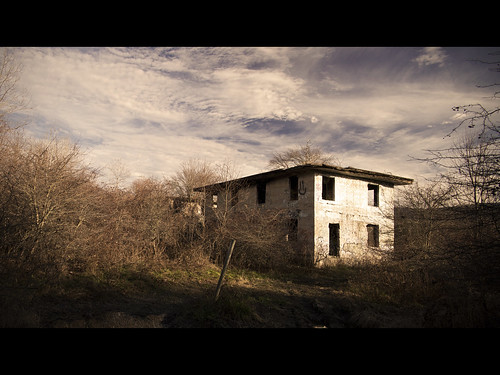This past weekend saw a fun, photography filled road trip through what I and those I was photographing with endearingly refer to as "Coal Country". A one day trip, half of which total likely having taken place in the cramped space of a car, cruising through rolling hills coated in dead and albino-bleached trees. The ensuing back pain was well worth it.
We met up early in the morning, on the brink of twilight just before sunrise would blanket the landscape with golden light. Our itinerary had only one specific location set firmly in stone, the rest of the trip being much more wishy-washy and open to spur of the moment ideas. Though an enjoyable and very much fruitful venture, I find myself wanting to take it again on the sooner rather than the later. It felt like a dry run, a first impression of the subject, and with knowledge now of what works and what doesn't, the second trip would be an assured tapping into a photographic gold mine.
On the subject of the "what works" elements I discovered in my dry run shooting, I actually tapped into something of a lost art that benefited my exterior shooting especially. Back when I was still sitting squarely in the Nikon camp (good lord, am I glad I'm done with those days of brand elitism), filter use seemed like an obvious route to go down. I was still in the habit of applying UV filters to all my lenses (again, so glad I'm not longer following antiquated practices), and every time I'd run to Ritz to pick up a new multi-coated piece of crappy glass I'd see what else was in their 52mm filter stock. My filter collection was pretty considerable by the time I realized I was never using the damn things, laden with starbursts and diffuse and neutral densities and polarizers. Ridiculous. Except for two - the NDs and the polarizers.
Though their function was clear as ever in my brain, their use seemed grossly unnecessary once the habit of shooting RAW became standard practice. At the time, nearly everything I shot with a filter saw the filter's effect negated by the tendencies of RAW processing. They had effect when shooting JPG, but there was no point to JPG shooting with Panasonic's lackluster rendering engine. Enough curiosity gripped me the morning of the trip that I grabbed the polarizer and ND before stepping out the door. Holy crap, am I glad curiosity bit.
How I could forget how gorgeously polarizer use affects skies is beyond me. The effect is simply delicious, and with on-board bias of white balance favoring the warm, the exposures didn't suffer the ugly blue cast typical of all Quantaray filters (the cheapest of the cheap). Sharpness was unaffected because I wasn't forcing an image through a UV prior to the polarizer like I had done for years on my Nikon equipment (seriously, if you're using a UV, TAKE IT OFF). The skies, my god, the skies... they just looked... GOOD.
Though slightly less effective, the ND was another missed item in the bag. The joy of fast primes is the creamy bokeh and limit of area in focus when the aperture is able to keep wide open. In broad daylight, this is obviously not reasonable. However, slap that 2-stop ND on the lens and suddenly daylight shots are as creamy delicious as you'd ever want them to be. Again, with the E-P3's built-in A2 bias, the blue cast typical of Ritz's cheap filter glass wasn't an issue. Lovely!
Some time down the road I would do well to purchase a polarizer and ND set from a more respectable filter maker, B&W of maybe Tiffen. But in the mean time, I'll deal with on-camera filter fault correction.
Thursday, December 1, 2011
Subscribe to:
Post Comments (Atom)





No comments:
Post a Comment